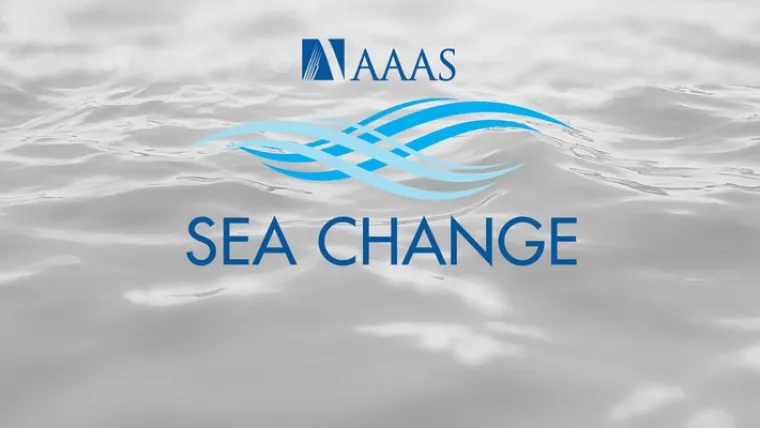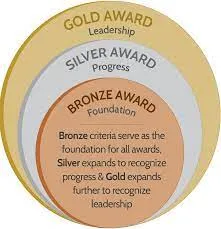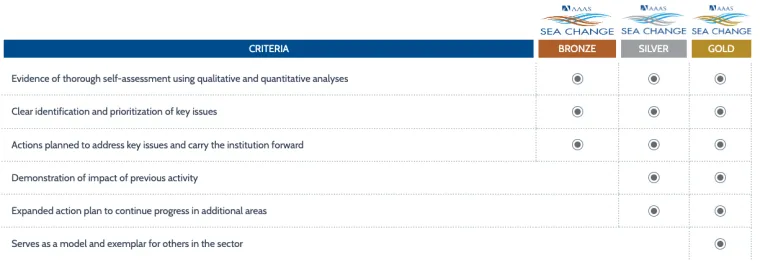
The University of Arizona has demonstrated its commitment to STEMM Equity through its institutional AAAS SEA Change Membership. The Office of Societal Impact is the Institutional Liaison. SEA (STEM Equity Achievement) Change is housed in the American Association for the Advancement of Science (AAAS), an international non-profit organization dedicated to advancing science, technology, and innovation for the benefit of all people. SEA Change is a comprehensive initiative from the AAAS that implements a proven self-assessment process to effect sustainable change with regard to diversity, equity, and inclusion in STEM at U.S. institutions of higher education. Join the effort.
SEA Change Awards recognize various stages of self-assessment and effective actions towards diversity, equity, and inclusion (DEI) in science, technology, engineering, mathematics, and medicine (STEMM). Each Award type focuses on a different element of systemic change, but the overall concept (including the SEA Change process and award levels) is the same for each. All SEA Change guidelines emphasize the need to understand root causes of inequity, encouraging deep analysis of policies, practices, programs, and processes and if they differentially impact the experiences of people on campus. Learn more here.
Our members:
- Access knowledge and tools to guide self-assessment
- Identify their own context-specific barriers and opportunities
Develop and implement action plans
Awards Overview: SEA Change Awards recognize various stages of self-assessment and effective actions towards diversity, equity, and inclusion (DEI) in science, technology, engineering, mathematics, and medicine (STEMM). Each Award type focuses on a different element of systemic change, but the overall concept (including the SEA Change process and award levels) is the same for each. All SEA Change guidelines emphasize the need to understand root causes of inequity, encouraging deep analysis of policies, practices, programs, and processes and if they differentially impact the experiences of people on campus.

Each award type concentrates on different approaches necessary for systemic change: "top-down" (Institutional Awards), "bottom-up" (Departmental Awards), and "bi-directional" (Biomedicine Awards). More information about specific awards is provided below.
Each award type has a set of questions or considerations—referred to as guidelines—that enable an institution, department, or biomedical endeavor to explore qualitative and quantitative evidence using an intersectional lens. SEA Change provides guidance for synthesis and evaluation of these data to understand how policies, climate, and culture are impacting everyone within the applicant entity. Using that understanding, institutions, departments, and biomedical endeavors can develop an action plan to address any gaps in information and take steps towards removing barriers to equity.

Each award application includes a narrative detailing the "30,000-foot view" of findings from self-assessment and a five-year action plan focused on DEI. To prevent backsliding and to encourage capacity-building, awards must be renewed within five years or they expire. At the time of renewal, applicants may request to renew at their current level or apply to progress to the next level.

SEA Change Awards have three levels: Bronze, Silver, and Gold
Membership Benefits
i. Participation in an immersive SEA Change cohort for capacity building during first-time self-assessment and action planning; 1:1 virtual consultation with SEA Change staff as requested for emerging issues as schedules allow
ii. Quarterly 1:1 virtual consultation with SEA Change staff or designates for current Awardees as requested
iii. Opportunity to submit Institutional and/or Biomedicine Award Letters of Intent and applications
iv. Limited number of waived registration fees for SEA Change Institute courses, with greatly reduced rates for additional seats.
v.Public commitment to SEA Change Principles and use of SEA Change Member logo (CharterMembers, see Appendix A) on Institutional materials within SEA Change design/trademark requirements to indicate that commitment.
vi. Access to SEA Change resource materials
vii. Access to Members-only activities, areas of the SEA Change Community, and areas of the SEA Change website
viii. Opportunities to network with SEA Change Members and others interested in the SEA Change objectives
ix. Up to one annual site visit (not to exceed one day or $1000 in travel and accommodations without further arrangements) from SEA Change staff as requested for training or consultation within scheduling constraints
Mission: SEA Change seeks to inspire, guide, and support voluntary transformation of colleges and universities so that the environment for research and education in science, technology, engineering, mathematics, and medicine (STEMM) is excellent, equitable, diverse, and inclusive.
Vision: We envision an excellent, diverse, equitable, and inclusive STEMM ecosystem.
Approach: Colleges and universities and the departments within them use research-informed strategies and supportive community of peers to build capacity for, and implement, transformation. Our program strives for a culture change that makes DEI in STEMM normative and inextricably linked to excellence.
Principles: STEMM Equity Achievement (SEA) Change supports institutional transformation, with an initial focus on colleges and universities, enabling success in high quality education and research missions by ensuring that the full range of individual talent can be recruited, retained, and advanced in science, technology, engineering, mathematics, and medicine (STEMM).
By joining SEA Change, Member Institutions commit to equity and full participation of each individual across gender (including gender, gender identity, and gender expression), race, ethnicity, disability status, socioeconomic status, sexual orientation, age, familial history of higher education, and any other factor that is unrelated to ability and has been the target of bias and unequal treatment. Bias, marginalization, and exclusion have prevented the full engagement of a broad range of individuals that is needed to maximize creativity and quality, as well as the full engagement of the promise of available talent, in STEMM education and careers.
- We believe colleges and universities cannot reach their full potential to contribute to all students and the larger society unless they can include, engage, and benefit from the talents of broadly diverse groups of students, faculty, and others in their communities.
- We believe the role of higher education systems is to serve all who are interested, committed, and have promise; we aspire to provide an inclusive culture of learning and respect, overcoming stereotypes and addressing biases.
- We believe that advancing equity requires dedication and action from all levels of the organization, including supportive central and local governance and accountability structures and active leadership from those in senior roles; institutional leaders commit themselves to take action to inspire and foster commitment of others across the institution, accordingly.
- We recognize the long-term commitment and important contributions of institutions whose historical missions are to serve specific populations of students historically excluded from academic opportunities available to others.
- We acknowledge that all individuals have multiple individual identities, and we commit to considering the intersection of those identities whenever possible.
- We also acknowledge that every individual experiences identity differently and is unique; membership in a group does not mean acceptance of the idea of homogeneity within that group. Heterogeneous groups reinforce the need to build structures that affirm the support of person-centered policies and reject society’s stereotyping and structural inequity.
- We aspire to remove the additional systemic and structural barriers and obstacles that compound the usual challenges in higher education facing everyone and are statistically more likely to be faced by individuals from groups that are affected by inequity at major points of educational, professional, and career development and progression.
- We aspire to shift institutional culture and climate, ensuring that regardless of demographic and identity characteristics unrelated to potential and performance in STEMM, individuals are respected and enabled to be productive and to contribute to the advancement and application of knowledge.
- We aspire to develop solutions to inequity that build upon organizational governance and accountability structures and systems at the central and local level, including metrics and evidence-based evaluation, standards, policies, processes, and roles and responsibilities transcending individuals employed at a particular time.
- We aspire for solutions to inequity to involve collaboration of those who are targets of inequity and those who are not, knowing that the burden of change should not rest on individuals experiencing barriers that stem from those inequities. The cost of participation by those with identities targeted by bias should be recognized and addressed equitably.We commit to embracing equity, diversity, and inclusion as central elements of excellence in academia, business, and industry; we recognize that high performance results from the inclusion of all committed individuals of promise, and that STEMM excellence requires programs, policies, and practices that support a welcoming and professional climate and culture for inclusion of all.
- We commit to addressing the current structural and systemic inequities affecting different populations and groups across STEMM disciplines, particularly barriers that result in the absence or near-absence of diversity within student bodies and senior academic and professional roles, as well as in business and industry.
- We commit to identifying and aspire to addressing both explicit and implicit biases that lead to exclusionary conduct and perpetuate structures and systems of inequity across our institution, and we understand that such conduct is a barrier to enhancing excellence.
- We commit to building a community that is actively intolerant of exclusionary conduct and that establishes standards of excellence requiring both high quality work and professional conduct (which by definition is intolerant of exclusionary practices).
- We commit to using organizational structures and systems, including related resource allocation, to support better design, evaluation, and continuous improvement of those structures and systems—as well as of transactional strategies (individual programs and projects) aimed at enhancing diversity and inclusion—to make the structures, systems, and strategies more effective and sustainable.
Note: The phrase “inequities affecting or targeting some populations” is used across the principles to denote that often, even if certain groups are well-represented, they are still not being equitably served or fully included due to bias, stereotype, and marginalization.
The University of Arizona has demonstrated its commitment to STEMM Equity through its institutional AAAS Sea Change Membership. The Office of Societal Impact is the Institutional Liaison.
See What Other Universities Are Doing
Arizona State University
SEA Change recently gave ASU a bronze-level award for its efforts in STEM equity and inclusion. ASU was one of only five universities given this distinction, the highest level of recognition ever awarded.
Boston University
SEA Change is an initiative from the American Association for the Advancement of Science (AAAS) that seeks to recognize institutions for their work in support of diversity, equity, and inclusion in the STEMM (science, technology, engineering, mathematics and medicine) fields.
Boston University was involved in the development of this program from its earliest days and we received one of the program’s inaugural AAAS SEA Change Bronze Awards in 2019. Below is the application that BU submitted for the program, which is made available here to the BU community.
University of California, Davis
Two years after UC Davis became one of three charter members of the STEMM Equity Achievement (SEA) Change program of the American Association for the Advancement of Science, the University of California today (May 24) signed up to SEA Change as a system, the first institution to do so.
University of California, Irvine
even UC Irvine researchers in areas ranging from engineering and chemistry to sociology and anthropology have been named fellows of the American Association for the Advancement of Science, the world’s largest general scientific society. A total of 416 AAAS members were honored this year for their efforts to further science or its applications. New fellows each received an official certificate and a gold-and-blue rosette pin in February at the organization’s annual meeting in Washington, D.C. The honorees were formally announced Nov. 27 in the AAAS News & Notes section of the journal Science.
University of Florida
The American Association for the Advancement of Science (AAAS), the world’s largest general scientific society and publisher of the Science family of journals, has elected 19 faculty from the University of Florida to its newest class, breaking previous records for the number of faculty awarded in a single year. The honor, which includes alumni such as Thomas Edison and W.E.B. DuBois, is among the most distinctive in academia and recognizes extraordinary impact and achievement across disciplines, from research, teaching, and technology, to administration in academia, industry and government, to excellence in communicating and interpreting science to the public.
University of Massachusetts, Lowell
The American Association for the Advancement of Science (AAAS) honored UMass Lowell on Feb. 13 for its commitment to diversity, equity and inclusion in STEM and furthering positive change in the institution’s relevant policies and practice.

